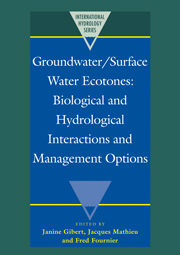Book contents
- Frontmatter
- Contents
- List of authors
- Preface
- I INTRODUCTION
- II FUNCTION OF GROUNDWATER / SURFACE WATER INTERFACES
- III MALFUNCTION OF GROUNDWATER / SURFACE WATER INTERFACES: CAUSES AND METHODS OF EVALUATION
- 19 Heterogeneity of groundwater-surface water ecotones
- 20 Failure of agricultural riparian buffers to protect surface waters from groundwater nitrate contamination
- 21 Stable nitrogen isotope tracing of trophic relations in food webs of river and hyporheic habitats
- 22 La zone hypodermique du sol écotone entre eaux météoriques et eaux souterraines dans l'infiltration des pesticides dissous
- 23 Soils of the north-eastern coast of the Caspian Sea as the zone of sea water/groundwater interaction
- IV MANAGEMENT AND RESTORATION OF GROUNDWATER / SURFACE WATER INTERFACES
- V CONCLUSION
- ANNEX
21 - Stable nitrogen isotope tracing of trophic relations in food webs of river and hyporheic habitats
Published online by Cambridge University Press: 07 September 2010
- Frontmatter
- Contents
- List of authors
- Preface
- I INTRODUCTION
- II FUNCTION OF GROUNDWATER / SURFACE WATER INTERFACES
- III MALFUNCTION OF GROUNDWATER / SURFACE WATER INTERFACES: CAUSES AND METHODS OF EVALUATION
- 19 Heterogeneity of groundwater-surface water ecotones
- 20 Failure of agricultural riparian buffers to protect surface waters from groundwater nitrate contamination
- 21 Stable nitrogen isotope tracing of trophic relations in food webs of river and hyporheic habitats
- 22 La zone hypodermique du sol écotone entre eaux météoriques et eaux souterraines dans l'infiltration des pesticides dissous
- 23 Soils of the north-eastern coast of the Caspian Sea as the zone of sea water/groundwater interaction
- IV MANAGEMENT AND RESTORATION OF GROUNDWATER / SURFACE WATER INTERFACES
- V CONCLUSION
- ANNEX
Summary
ABSTRACT Natural isotopic abundances of N (d15N) in organic matter are used to examine the trophic relations in river and hyporheic habitats of the Flathead River, Montana. The d15N of biofilms and Plecopteran-dominated food webs are compared for river and hyporheic waters. We examine the concept that the isotope ratio of an animal undergoes both the food source effect and in vivo metabolic effects. Metabolic effects for nitrogen isotopes in animal tissues relates to isotopic fractionation, which exhibits progressive enrichment of the d15N in body tissues at higher trophic levels. These ∇ d15N enrichments are in excess of isotopic abundances of food sources. Comparisons show greater enrichment for the consumer trophic levels of the hyporheic than river channel habitat. The d15N contents of the hyporheic food webs suggest influences of different concentrations and d15N contents of NO3 and NH4. These inorganic conditions may be controlled by physical mixing of various water masses, Ntransformations associated with biofilm microbiota, and feedbacks of NH4 through excretion by animals. Our observations indicate that stable isotopes may be powerful tools for determining nitrogen source and process information in hyporheic habitats.
INTRODUCTION
Little is known about the trophic ecology of food webs within the hyporheic ecotones of river ecosystems (Hendricks, 1993). In our study, stable nitrogen isotopes measurements (d15N) are used to examine the trophic relations in river and hyporheic habitats of the Flathead River, Montana. The d15N of biofilms and Plecopteran-dominated food webs are compared for river and hyporheic waters. The almost total coverage on most rock surfaces by biofilms suggests that attached microbiota comprise a dominant food resource in both the river channel and hyporheic habitats.
- Type
- Chapter
- Information
- Groundwater/Surface Water EcotonesBiological and Hydrological Interactions and Management Options, pp. 166 - 171Publisher: Cambridge University PressPrint publication year: 1997
- 4
- Cited by

